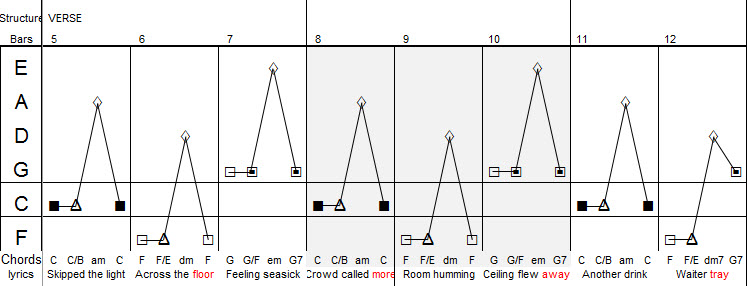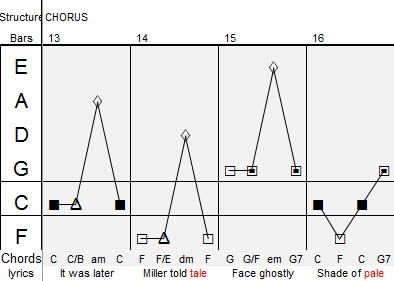Top 20 songs explained
I am embarking on this project to analyse the chords of the top 20 songs of all time to see if there is anything hidden in those chord progressions that links them all, or whether each one is its own succinct packet of genius. Stick with me as we journey through some all time classics. There are so many differing lists when it comes to the top 10, 20, 100, 500 songs. I have chosen the list from everyhit.com which in turn has compiled its list from The BBC, Virgin, Guinness and Mojo. There are some that I have already analysed in detail elsewhere on this site and youtube but I shall include them here also.
Bohemian Rhapsody by Queen—Imagine by John Lennon—Angels by Robbie Williams—Hey Jude by Paul McCartney —Smells Like Teen Spirit by Nirvana (Kurt Cobain)—Live Forever by Oasis —Wonderwall by Oasis—One by U2 —Bitter Sweet Symphony by The Verve — With or Without You by U2 — Penny Lane and Strawberry Fields by The Beatles—Good Vibrations by The Beach Boys—Losing my Religion by R.E.M—Like a Rolling Stone by Bob Dylan—God Only Knows by The Beach Boys—Everybody Hurts by REM— Waterloo Sunset by The Kinks—Don’t Look Back in Anger by Oasis—Whiter Shade of Pale by Procul Harum—Stairway to Heaven by Led Zeppelin
 Bohemian Rhapsody
Bohemian Rhapsody
The Behemoth that is Bohemian Rhapsody by Queen obeys few laws of conventional song writing. However, in amongst the wild chromatic passages, operatic harmonies and shocking key changes lies some recognisable and conventional song writing. Let’s start with the introduction:  Bohemian Rhapsody is in the key of Bb. It starts in Bb (although it does not feature until the fourth chord), the verses are in Bb and it finishes in Bb. The introduction goes as follows: Is this the real life <gm7> or <Bb6> Is this just fantasy <C7> Caught in a landslide <f7> No escape from reality. <Bb> Things continue fairly conventionally until bar 10: Easy come, easy go…. Now the harmony has become intensely chromatic for the firsst time of many in this song. I do not remember seeing such violent chromatic changes in a song. All this before the first verse starts:
Bohemian Rhapsody is in the key of Bb. It starts in Bb (although it does not feature until the fourth chord), the verses are in Bb and it finishes in Bb. The introduction goes as follows: Is this the real life <gm7> or <Bb6> Is this just fantasy <C7> Caught in a landslide <f7> No escape from reality. <Bb> Things continue fairly conventionally until bar 10: Easy come, easy go…. Now the harmony has become intensely chromatic for the firsst time of many in this song. I do not remember seeing such violent chromatic changes in a song. All this before the first verse starts:  The first Verse begins in similar fashion to the introduction with the addition of the genuine I chord at the start on the word “Mama”. This is looking like any other verse in the jump up from the tonic (I or Bb) to the relative minor (vi or gm) and a fall back down through the fifths to the tonic again. Written as chords it looks like this: Bb-gm-cm-F7 Bb-gm-cm-F7. Then a stroke of genius in the cadence on “Nothing really matters”. The chords are abmin-Eb. This use of the b7min chord (abmin) is most unusual and creates a sad, lonely feel which is of course heightened by the words. The second verse is identical to the first so that we are really settled into a conventional Intro-Verse1-Verse2 structure. Now we would expect a chorus or a bridge. Expectations are foolish in this song, we now have a pre-bridge which is a small lead guitar solo:
The first Verse begins in similar fashion to the introduction with the addition of the genuine I chord at the start on the word “Mama”. This is looking like any other verse in the jump up from the tonic (I or Bb) to the relative minor (vi or gm) and a fall back down through the fifths to the tonic again. Written as chords it looks like this: Bb-gm-cm-F7 Bb-gm-cm-F7. Then a stroke of genius in the cadence on “Nothing really matters”. The chords are abmin-Eb. This use of the b7min chord (abmin) is most unusual and creates a sad, lonely feel which is of course heightened by the words. The second verse is identical to the first so that we are really settled into a conventional Intro-Verse1-Verse2 structure. Now we would expect a chorus or a bridge. Expectations are foolish in this song, we now have a pre-bridge which is a small lead guitar solo: 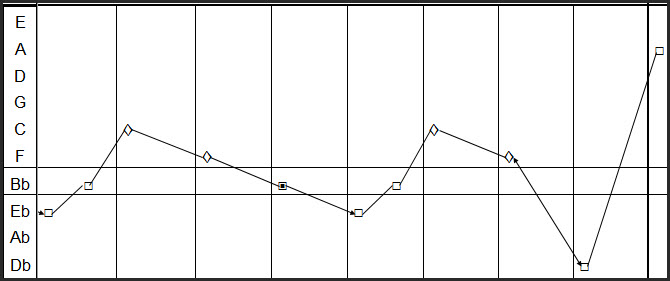 The extraordinary key change at the end of this solo to A major is totally unprepared (we have not heard this chord in the song so far or its dominant) and is an enharmonic change from Db to A major. This is certainly a point in the music where we would expect a cadence and a key change, but to have a III-I in the new key would normally be considered very weak. It is certainly not weak in this case. The new key stridently establishes itself with a series of marching chords in the new key:
The extraordinary key change at the end of this solo to A major is totally unprepared (we have not heard this chord in the song so far or its dominant) and is an enharmonic change from Db to A major. This is certainly a point in the music where we would expect a cadence and a key change, but to have a III-I in the new key would normally be considered very weak. It is certainly not weak in this case. The new key stridently establishes itself with a series of marching chords in the new key:  Now Freddie Mercury really starts to flex his creative muscles. The new key is established with repeated us of the IV chord (D) in the new key. The melody is still using the chromatic theme introduced earlier but the harmony is more static this time and does not move chromatically as before. As soon as the words, “Thunderbolt and Lightning, very very frightening” come in the harmony goes totally mad. The changes from Ab-C-E is jumping up in major thirds or up through an augmented chord. John Coltraine uses similar changes in his masterpiece, Giant Steps. Mercifully the E7 chord returns us to the new home key of A and we enter the “Gallileo” section. Astonishingly the chords then jump back down through the same chords – A-cm- Ab, and the next section “I’m just a poor boy” is in the key of Ab.
Now Freddie Mercury really starts to flex his creative muscles. The new key is established with repeated us of the IV chord (D) in the new key. The melody is still using the chromatic theme introduced earlier but the harmony is more static this time and does not move chromatically as before. As soon as the words, “Thunderbolt and Lightning, very very frightening” come in the harmony goes totally mad. The changes from Ab-C-E is jumping up in major thirds or up through an augmented chord. John Coltraine uses similar changes in his masterpiece, Giant Steps. Mercifully the E7 chord returns us to the new home key of A and we enter the “Gallileo” section. Astonishingly the chords then jump back down through the same chords – A-cm- Ab, and the next section “I’m just a poor boy” is in the key of Ab. 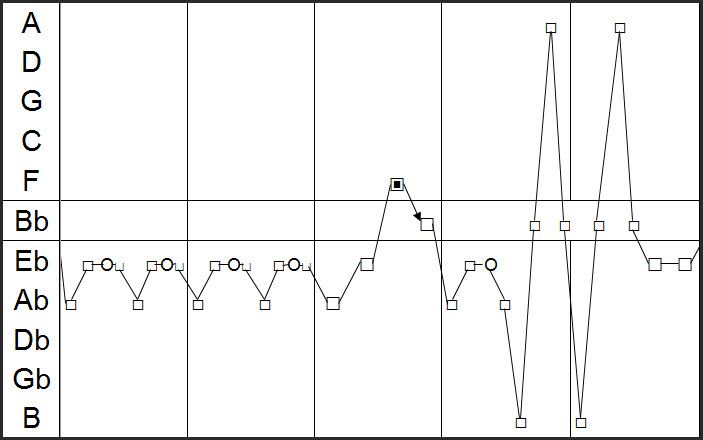 We can see the same pattern as before with chromatic melody but fairly tight harmony. Then a return to the true chromaticism in a direct repetition from bar 10, “Easy come, easy go”. Now we enter the strangest and most explorative writing in the whole piece both lyrically and musically. “Bismillah”
We can see the same pattern as before with chromatic melody but fairly tight harmony. Then a return to the true chromaticism in a direct repetition from bar 10, “Easy come, easy go”. Now we enter the strangest and most explorative writing in the whole piece both lyrically and musically. “Bismillah”  The music is now centered around Eb (the IV of the original Bb). Repeated use of the Bb7 chord followed by Eb establishes Eb as the new key. A frenzied series of V7-I progressions in different keys (B, D Gb, Eb) is followed by a huge build up on the chord of Bb7. It can only go one place. Surely even Freddie Mercury cannot buck the most sacred progression in the whole of music? A repeated V7 chord (Bb7) must fall a fifth to a new tonic I (Eb) and…
The music is now centered around Eb (the IV of the original Bb). Repeated use of the Bb7 chord followed by Eb establishes Eb as the new key. A frenzied series of V7-I progressions in different keys (B, D Gb, Eb) is followed by a huge build up on the chord of Bb7. It can only go one place. Surely even Freddie Mercury cannot buck the most sacred progression in the whole of music? A repeated V7 chord (Bb7) must fall a fifth to a new tonic I (Eb) and…  Yes! We are in Eb and most emphatically so. The “Wigout” head-banging section stays true to the tenets of music harmony and uses very conventional chords.
Yes! We are in Eb and most emphatically so. The “Wigout” head-banging section stays true to the tenets of music harmony and uses very conventional chords.  Time for another solo which is characterised by repeated use of major tonalities. Again the harmony seems to be able to leap around without any regard for musical sensibilities. If we were to write the chord sequence of the above it would read like this: Eb – Eb – F – Gb – B – Ab – Bb – Bb7 – Eb – Bb I – I – II -bIII-bVI-IV – V – V7 – I – V Flat 3 and flat 6 major chord? Crazy, yet now so familiar that it seems to create its own sense of logic. We are nearing the end now with one final heroic outro:
Time for another solo which is characterised by repeated use of major tonalities. Again the harmony seems to be able to leap around without any regard for musical sensibilities. If we were to write the chord sequence of the above it would read like this: Eb – Eb – F – Gb – B – Ab – Bb – Bb7 – Eb – Bb I – I – II -bIII-bVI-IV – V – V7 – I – V Flat 3 and flat 6 major chord? Crazy, yet now so familiar that it seems to create its own sense of logic. We are nearing the end now with one final heroic outro:  “Nothing really matters, Anyone can see Nothing really matters… To me” Now we have mainly minor harmonies for this resigned farewell. Only on “To me” do we get back to a major tonality and a conventional finish, albeit in a different key (Eb) than we started in (Bb). There really is very little comparison with other works in the popular music genre. There is plenty of strange and exotic music and songs out there. Zappa’s songs pay just as little heed to convention, but it is the overwhelming popularity of such an unconventional song that sets Bohemian Rhapsody apart. It has been the focus of my analysis for many years and it never fails to reveal new secrets upon each inspection. There is an animated version of some of this analysis here if you would like to see more.
“Nothing really matters, Anyone can see Nothing really matters… To me” Now we have mainly minor harmonies for this resigned farewell. Only on “To me” do we get back to a major tonality and a conventional finish, albeit in a different key (Eb) than we started in (Bb). There really is very little comparison with other works in the popular music genre. There is plenty of strange and exotic music and songs out there. Zappa’s songs pay just as little heed to convention, but it is the overwhelming popularity of such an unconventional song that sets Bohemian Rhapsody apart. It has been the focus of my analysis for many years and it never fails to reveal new secrets upon each inspection. There is an animated version of some of this analysis here if you would like to see more.
 Imagine by John Lennon
Imagine by John Lennon
This beautiful and simple piece of song writing contains some interesting twists that make it unique. Of course there is much in the rocking piano accompaniment, the voicing and arrangement but the harmony is well worth a look. Here is the SeeChord chart of the verse:  Much like the piano part, the harmony also rocks back and forth between C and F. This continues for 8 bars, and then there is a 4 bar add on which is the classic jump up and fall back down through fifths that we see so many times in music. The jump from F major to am is a relative major-relative minor change. Then we go through the fifths am-dm-G-C. The second verse starts with C so we have completed a classic and classical cycle of fifths progression. In the second verse this progression is not completed and so we enter the next section with an F chord.
Much like the piano part, the harmony also rocks back and forth between C and F. This continues for 8 bars, and then there is a 4 bar add on which is the classic jump up and fall back down through fifths that we see so many times in music. The jump from F major to am is a relative major-relative minor change. Then we go through the fifths am-dm-G-C. The second verse starts with C so we have completed a classic and classical cycle of fifths progression. In the second verse this progression is not completed and so we enter the next section with an F chord.  Now the section I’ve called the chorus (it’s not really a traditional chorus as such but we have to call it something!). It starts with a traditional F-G-C (IV-V-I) and then the surprise E7 (III7). There is little in music theory that can explain the use of E7 at this point. It is not unheard of to jump to III7 (the dominant 7th chord on the 3rd degree of the scale) but we would expect, almost demand an A chord next. This fulfils the need for music to fall back through the fifths as we saw in the verse. However, instead of a fall to A, we get the pattern repeated starting on the F Major chord again. In music theory language we could call this an interrupted cadence, but it doesn’t seem to quite fit what is happening here. An interrupted cadence would normally be followed by a perfect cadence to finish off the interruption. There is no E7-A so the interruption is never completed. We do get a perfect cadence in the home key of C at the end of this section which gives us the finished feeling that is so common in all music. In fact, John Lennon often uses a Plagal (IV-I) cadence in his songs whereas McCartney favours the Perfect (V-I) cadence. See the page Secrets of the Beatles for loads more analysis of their songs.
Now the section I’ve called the chorus (it’s not really a traditional chorus as such but we have to call it something!). It starts with a traditional F-G-C (IV-V-I) and then the surprise E7 (III7). There is little in music theory that can explain the use of E7 at this point. It is not unheard of to jump to III7 (the dominant 7th chord on the 3rd degree of the scale) but we would expect, almost demand an A chord next. This fulfils the need for music to fall back through the fifths as we saw in the verse. However, instead of a fall to A, we get the pattern repeated starting on the F Major chord again. In music theory language we could call this an interrupted cadence, but it doesn’t seem to quite fit what is happening here. An interrupted cadence would normally be followed by a perfect cadence to finish off the interruption. There is no E7-A so the interruption is never completed. We do get a perfect cadence in the home key of C at the end of this section which gives us the finished feeling that is so common in all music. In fact, John Lennon often uses a Plagal (IV-I) cadence in his songs whereas McCartney favours the Perfect (V-I) cadence. See the page Secrets of the Beatles for loads more analysis of their songs.
 Angels – Robbie Williams
Angels – Robbie Williams
I love this song although at first I found it smarmy and predictable, it is one of those that burrowed its way deeper and deeper and now seems like it is part of the liturgy of music history. It is the simplest of the songs so far with really very little to comment on harmonically. Here is the start of the verse: 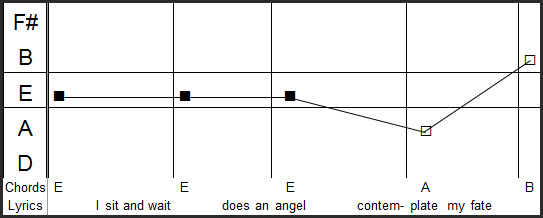 As you can see, the song starts in the home key of E Major and uses the IV(A major) and V(B major) as we would expect from a conventional song or piece of classical music. The second half of the verse holds a few surprises:
As you can see, the song starts in the home key of E Major and uses the IV(A major) and V(B major) as we would expect from a conventional song or piece of classical music. The second half of the verse holds a few surprises:  Now we seem to be avoiding the home key of E and see-sawing between relative majors and minors. F#minor to A major and then c# minor. At the end of this section we get a classic rock progression that rises through fifths, D-A-E. This contrasts with classical music that will tend to fall through fifths. We can expect so see this movement a lot in the top 50 songs.
Now we seem to be avoiding the home key of E and see-sawing between relative majors and minors. F#minor to A major and then c# minor. At the end of this section we get a classic rock progression that rises through fifths, D-A-E. This contrasts with classical music that will tend to fall through fifths. We can expect so see this movement a lot in the top 50 songs.  This is the chorus and we are in very familiar territory now. This is a variation on the classic 4-chord song that a huge quantity of hit songs use (see the amazing axis of awesome video). The progression is most often seen in the form I-V-vi-IV which would be E-B-c#m-A. This is the same progression, but simply starting on the B so B-c#m-A-E.
This is the chorus and we are in very familiar territory now. This is a variation on the classic 4-chord song that a huge quantity of hit songs use (see the amazing axis of awesome video). The progression is most often seen in the form I-V-vi-IV which would be E-B-c#m-A. This is the same progression, but simply starting on the B so B-c#m-A-E.  After the classic four chord progression we get the same rising fifths chords to finish the chorus as we did in the verse, D-A-E. The last section of note is the instrumental which holds few surprises:
After the classic four chord progression we get the same rising fifths chords to finish the chorus as we did in the verse, D-A-E. The last section of note is the instrumental which holds few surprises:  It is worth noting that the chord on V which would normally be major is now minor. This gives a slightly more emotional feel to the section which is otherwise of little note. Perhaps this song is a classic example of how to use conventional song writing to great effect. It is a reminder that it is not necessary to fling yourself around the wild chords of Bohemian Rhapsody to write a classic. I’m quite sure that many of these progressions will crop up over and over again in the next 47 songs, but we will just have to wait and see if that is true.
It is worth noting that the chord on V which would normally be major is now minor. This gives a slightly more emotional feel to the section which is otherwise of little note. Perhaps this song is a classic example of how to use conventional song writing to great effect. It is a reminder that it is not necessary to fling yourself around the wild chords of Bohemian Rhapsody to write a classic. I’m quite sure that many of these progressions will crop up over and over again in the next 47 songs, but we will just have to wait and see if that is true.
 Hey Jude
Hey Jude
Familiar territory here with the McCartney classic Hey Jude. The ubiquitous sing-along at the end, the cheesy chord progressions, we are expecting nothing but conventionality from the less experimental of the Beatles song writing team of Lennon and McCartney. Let’s find out if that is true. Here is the verse: Look like a classic key establishment here. I-V-V7-I (F-C-C7-F). Making sure the listener knows the home key so that when we travel away from it we will feel like we are returning to a warm cosy fire when we return. So far, just 3 chords, I, IV and V, just the same as the start of Angels. After a repetition of the verse we get a pre-chorus that looks like this:
Look like a classic key establishment here. I-V-V7-I (F-C-C7-F). Making sure the listener knows the home key so that when we travel away from it we will feel like we are returning to a warm cosy fire when we return. So far, just 3 chords, I, IV and V, just the same as the start of Angels. After a repetition of the verse we get a pre-chorus that looks like this:  A simple use of the dominant 7 chord on the tonic (F7) leads us to a chorus in Bb (the subdominant or IV). This is a classic move to modulate to a different key using a perfect cadence, and we would expect another one to get us back to the verse (C7-F). Now the chorus:
A simple use of the dominant 7 chord on the tonic (F7) leads us to a chorus in Bb (the subdominant or IV). This is a classic move to modulate to a different key using a perfect cadence, and we would expect another one to get us back to the verse (C7-F). Now the chorus:  This could not be more conventional and it is the first time we have seen it in our top 50 songs so far. This is the jump up to the relative minor (gm) and falling back down through the fifths. Notice how the F chord is sounded, and then F7 to lead us back to Bb and then the pattern is repeated again. Slightly odd that although the chorus is in Bb, it finishes on F. We need a good solid C7 now…
This could not be more conventional and it is the first time we have seen it in our top 50 songs so far. This is the jump up to the relative minor (gm) and falling back down through the fifths. Notice how the F chord is sounded, and then F7 to lead us back to Bb and then the pattern is repeated again. Slightly odd that although the chorus is in Bb, it finishes on F. We need a good solid C7 now…  And there it is. The chorus has a little extension and a C7 chord is used to take us back to F. I have to say that this is a very crowbar-y use of cadence to modulate. Both times the modulation was outside the usual 8-bar structure of a verse or chorus, and in the case of the chorus there aren’t even any words (na na na na na…na na na…na na na)! Anyhow we end up back at the verse in F. Then of course there is the famous outro:
And there it is. The chorus has a little extension and a C7 chord is used to take us back to F. I have to say that this is a very crowbar-y use of cadence to modulate. Both times the modulation was outside the usual 8-bar structure of a verse or chorus, and in the case of the chorus there aren’t even any words (na na na na na…na na na…na na na)! Anyhow we end up back at the verse in F. Then of course there is the famous outro:  Now we have seen this already, “I’m loving angels instead”. A rock progression that I am quite sure we will see many more times. This is a great way to make a song sound rockier by simply using the bVII chord (the chord on the 7th degree of the scale flattened!). To see more Beatles songs analysed visit my secrets of the Beatles page.
Now we have seen this already, “I’m loving angels instead”. A rock progression that I am quite sure we will see many more times. This is a great way to make a song sound rockier by simply using the bVII chord (the chord on the 7th degree of the scale flattened!). To see more Beatles songs analysed visit my secrets of the Beatles page.
 Smells Like Teen Spirit
Smells Like Teen Spirit
So this song was familiar to me although I confess I never really focussed on it much before now. There are a few things to mention before we get going with an analysis. Firstly I have to lament the guitar tab sites that I visited to check my ears when it came to the chords in this song. Most of the sites I visited showed the song in E when it is in F. Secondly due to the use of power chords for the entire song, the tonality (major or minor) for each chord is only implied and therefore should not be played. When full chords are played instead of power chords it is ridiculous to play F major and then Bb Major (or E major and then A major) as these chords are implied as minor chords not Major! Rant over, on to the song: The main riff which is used for the intro, verse and chorus goes as follows: F5 – Bb5 – Ab5 – Db5. The 5 denotes a power chord which is a chord that only contains the 1st and 5th notes from the scale, or to think of it another way, just the lowest and highest note of a chord in root position. There is a note that is missing from all of these chords and that is the 3rd. The 3rd is the note that gives a chord its tonality as being major or minor. Without this note in a chord we get a hard, edgy sound that is much used in rock. A common misconception is that power chords are neither major or minor. For the most part this is not true. The chords still retain a major or minor feel depending on their use and position in the song. Smells Like Teen Spirit is a great example of this as our ears fill in the missing notes for us and we very much get the impression that the following chords are being played: fm – Bbm – Ab – Db If you have a guitar handy (and you can play it!) then you could try filling in the chords and hearing what they sound like. You will find that they sound very similar to what we hear anyway. So how can this be? How can chords with notes missing be so readily identified as major or minor, even by an untrained ear? There are two main reasons that I can think of that explain this phenomenon. Melody The tune that Kurt is singing over the chords all belong to the same scale which is f minor or Ab Major. Both these keys can share the same scale depending on what version of f minor is being used. Here are the notes in the melody: F – G – Ab – Bb – C – Db – Eb – F So immediately we have two of the four chords defined for us. The F power chord must be an f minor, and the Ab power chord must be Ab major. The other two chords of the riff, Bb and Db are also defined by the scale. The Bb chord must be minor due to the Db in the melody, and the Db chord must be major due to the F in the melody. Although this seems complicated, it is a very common way of looking at the array of chords that can be used in a piece. The available chords that will fit in a song without too much effort are called “diatonic” chords. Do have a look at the major and minor page for a more detailed explanation of this. The Chords The chord progression itself is the other factor that informs our ears as to what tonality the power chords really are. Let’s take another look at the progression: F – Bb – Ab – Db. As all these chords also contain the 5th they in fact inform us entirely of the scale being used, without even the need of a melody. These are the notes that are being played: C – F – Eb – Ab – The 5ths F – Bb – Ab – Db – The 1sts There is enough there to tell us the implied 3rds of all the chords and therefore give us the sequence: fm – Bbm – Ab – Db. The other pattern that leaps out is the relative major/minor relationship between the chords in this sequence. fm-Ab Bbm – Db The progression plays the minor chords first – fm – Bbm. Then their relative majors, Ab – Db. Enough of the technical geeky overload. There is one more section of this song I have not discussed which comes just after the chorus. The chords are: F5 – Gb5 – F5 – Bb5 – Ab5. Again the harmony is implied and can be thought of as: fm – Gb – fm – Bb – Ab There is slight interest in the use of chromaticism going from the F to the Gb but the rest of this sequence is very traditional. This is one of those songs that seems to have just struck the right chord at the right time (excuse the terrible pun). Although there is nothing of great note in the use of harmony, I cannot find another song that uses the same chord progression. There is mention on the wiki entry that states the the progression is similar to “Louie Louie” by The Kingsmen or “More than a feeling” by Boston but this is rubbish as both of those songs are in the Major and therefore this progression would make no sense. Please do let me know if you find anything that uses i – iv – III – VI !
 Live Forever
Live Forever
Maybe I don’t really want to know How your garden grows I just want to fly. An iconic beginning to an iconic song. A quick peer into the world of its harmony reveals that it uses a limited set of purely diatonic chords (chords made up just from the notes in the scale) apart from one chord (Gb) and is very conventional. Brings up an interesting point though, why is conventional conventional? Here is a SeeChord chart of the verse: 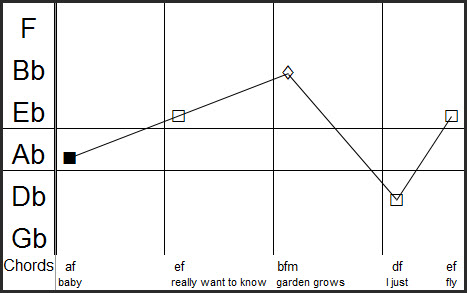 This is the opening phrase that is repeated exactly to give us the verse. It uses the chords: Ab-Eb-Bbm7-Db-Eb. or I-V-ii-IV-V. The Bb minor 7 chord is the same as a Db6 chord and the two chords are interchangeable and sometimes indistinguishable. In this case the harmony moves from the ii to the IV and both chords are fulfilling the same function which is to prepare for the V chord (Eb) which will then be followed by a I chord (Ab) to form a perfect cadence. Here is the rest of the song:
This is the opening phrase that is repeated exactly to give us the verse. It uses the chords: Ab-Eb-Bbm7-Db-Eb. or I-V-ii-IV-V. The Bb minor 7 chord is the same as a Db6 chord and the two chords are interchangeable and sometimes indistinguishable. In this case the harmony moves from the ii to the IV and both chords are fulfilling the same function which is to prepare for the V chord (Eb) which will then be followed by a I chord (Ab) to form a perfect cadence. Here is the rest of the song: 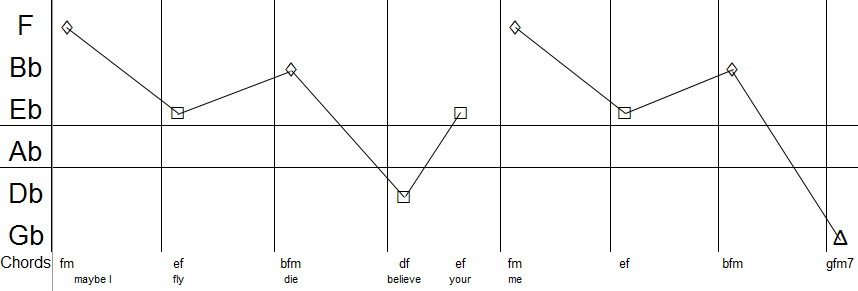 This starts with f minor which is the relative minor of Ab. The only real surprise is the use of the Gb major7 chord that is held at then end of this section on the words “forever”. I hesitate to interpret the use of this chord too much, but it is the first time we have strayed out of the comfort zone of I-ii-IV and V. It is ethereal and slightly mysterious. Not to say that conventional songs are boring, but this really gives us nothing new and is very easy to replicate using the most common chords in the most common order. Pick up an electric guitar and play C-F-G and dm and write about something, then play a bit around am and sing something else and there’s your song. Catchy and hugely popular though.
This starts with f minor which is the relative minor of Ab. The only real surprise is the use of the Gb major7 chord that is held at then end of this section on the words “forever”. I hesitate to interpret the use of this chord too much, but it is the first time we have strayed out of the comfort zone of I-ii-IV and V. It is ethereal and slightly mysterious. Not to say that conventional songs are boring, but this really gives us nothing new and is very easy to replicate using the most common chords in the most common order. Pick up an electric guitar and play C-F-G and dm and write about something, then play a bit around am and sing something else and there’s your song. Catchy and hugely popular though.
Wonderwall – Oasis
So the Gallaghers make it two in a row. Is “Wonderwall” more adventurous than “Live Forever” or just another 4-chord song? A great chance to compare the two. Firstly the intro and verse chords: F#m – A – E – B7. As any guitarist who has played this riff knows, there are a bunch of suspensions added on to these chords due to the fact that the top two strings stay on “E” and “A” the whole way through the song. I’ve left them out of the harmonic analysis as they are decorations mainly. Here’s the chart: So the song is in the key of f sharp minor. As with the vast majority of minor tonalities, both in Classical and Popular music, the music spends a lot of time around the relative major, in this case, A. This song could easily actually be in the key of A major but for the fact that the first and last chords are f#minor. I have just noticed a little pattern that the Seechord chart has thrown up. Have a look at these two sections, the first is the verse from “Live Forever”, the second from “Wonderwall”
So the song is in the key of f sharp minor. As with the vast majority of minor tonalities, both in Classical and Popular music, the music spends a lot of time around the relative major, in this case, A. This song could easily actually be in the key of A major but for the fact that the first and last chords are f#minor. I have just noticed a little pattern that the Seechord chart has thrown up. Have a look at these two sections, the first is the verse from “Live Forever”, the second from “Wonderwall”  It seems we may have stumbled across something here. Both songs use the same chord sequence. Now the actual chords are different, but their relation to each other is the same. This is why I find these charts so insightful as it can reveal patterns that are extraordinarily difficult to spot otherwise. Could this be the “sound” of an Oasis chord progression? We would (and will) have to examine the rest of their output to find out but I really like this. Lets have a look at the pre-chorus chords: D-E-f#m D-E-f#m D-E-A-f#m-B7
It seems we may have stumbled across something here. Both songs use the same chord sequence. Now the actual chords are different, but their relation to each other is the same. This is why I find these charts so insightful as it can reveal patterns that are extraordinarily difficult to spot otherwise. Could this be the “sound” of an Oasis chord progression? We would (and will) have to examine the rest of their output to find out but I really like this. Lets have a look at the pre-chorus chords: D-E-f#m D-E-f#m D-E-A-f#m-B7 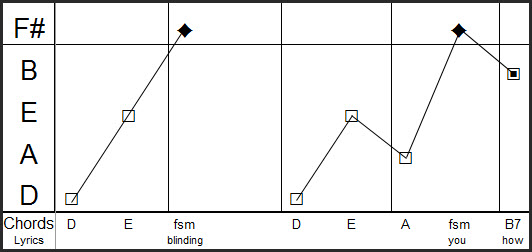 I like this. We could look at it and say that it is an interrupted cadence followed by a perfect cadence but I’m not entirely sure that is what the harmony is suggesting. The use of B7 at the end is also interesting. If I did not know the song and was just looking at the chart I would be tempted to say that this looks like there is about to be a key change into E major. This is because the B7 is a strong dominant 7th chord that is usually followed by the chord a 5th lower (E). It is also in the right position for a key change – right before the chorus. That however is not what happens:
I like this. We could look at it and say that it is an interrupted cadence followed by a perfect cadence but I’m not entirely sure that is what the harmony is suggesting. The use of B7 at the end is also interesting. If I did not know the song and was just looking at the chart I would be tempted to say that this looks like there is about to be a key change into E major. This is because the B7 is a strong dominant 7th chord that is usually followed by the chord a 5th lower (E). It is also in the right position for a key change – right before the chorus. That however is not what happens: 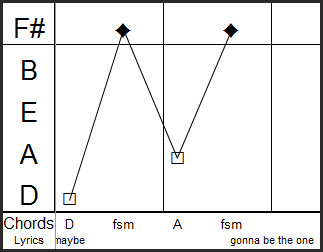 These chords are now repeated throughout the chorus. The chords are all closely related and are all only one note different from each other. The aspect that surprises me is that this chord sequence does not really feel like it is in f#minor or A, or D. There is no perfect cadence – either E7-A suggesting it is in A, or C#7 – f#m suggesting f#minor. This leaves a rather ambiguous feel that is not resolved at the end of the song either. I’m feeling that this is another trademark of Oasis, that sometimes we can be left hanging with a chord or a harmony that is not the most comfortable or obvious. Reminds me of some of The Beatles songs which can also fade out on ambiguous chords, or even start with them (Hard Day’s Night for example). Enough for now. Let me know if you know of any other Oasis songs that are similar and I’ll have a look into them for you!
These chords are now repeated throughout the chorus. The chords are all closely related and are all only one note different from each other. The aspect that surprises me is that this chord sequence does not really feel like it is in f#minor or A, or D. There is no perfect cadence – either E7-A suggesting it is in A, or C#7 – f#m suggesting f#minor. This leaves a rather ambiguous feel that is not resolved at the end of the song either. I’m feeling that this is another trademark of Oasis, that sometimes we can be left hanging with a chord or a harmony that is not the most comfortable or obvious. Reminds me of some of The Beatles songs which can also fade out on ambiguous chords, or even start with them (Hard Day’s Night for example). Enough for now. Let me know if you know of any other Oasis songs that are similar and I’ll have a look into them for you!
One-U2
“One love, one life” This is the anthem of all anthems and we can quickly see how the recipe was made. Here are the ingredients for a massive tune:
- Big Major Key of C Major (it starts in “a” minor but that doesn’t last long)
- Big theme – “One love, one life”.
- Soaring strings
- Lots of major guitar chords
It is reminiscent of “Bittersweet symphony” by The Verve which is actually next on the list. So this song starts out in “a” minor but quickly reveals that C Major is more like home, and is the key of the chorus. There are so many examples of music heading straight for the “relative major” that I wonder sometimes is we should not say that all music is in a major key but that sometimes it resides in the relative minor. Anyway back to the song. Here is the chart of the verse:  “Is it getting better Or do you feel the same Will it make it easier on you now You got someone to blame You say…” The D chord is ambiguous at first sounding as a “power chord”. This means that we dont have a 3rd in the chord. As a result, we cannot say whether the chord is major or minor. Pretty soon however the note is played or sung in the other parts confirming that the harmony is D major at this point. Songs in a minor key will often have far more chromaticism as there is not one single minor scale but rather a variety of scales that can interchange at will. This is often referred to as “modality” That fact comes in to play here and forms a distinctive part of the sound of this song. D major uses the notes: D – F# – A F major uses the notes: F – A – C. That means that there is a clash between the F sharp and the F natural in two adjacent chords. This is heard clearly in the guitar break after the second verse. This clash gives an edgy feel and the use of major chords makes it sound more “anthemic” – sure to get the crowd going. The chorus is established with a G Major to C Major progression. This is a “modulation” using a “perfect cadence” which establishes the key very securely. It is interesting that C Major gets a perfect cadence, but the starting key of “a” minor never gets its own. There is no E or E7 chord in the whole song which would be the V of “A” minor. The structure is Intro V Ch V Ch V Ch M8 Ch Outro (with V as Verse, Ch as Chorus and M8 as middle8) The chorus is unusual in that there are very few repeated words. It has a much more verse-like feel, but clearly acts as a chorus with the hook “One”. The chords are: C-am-F-C
“Is it getting better Or do you feel the same Will it make it easier on you now You got someone to blame You say…” The D chord is ambiguous at first sounding as a “power chord”. This means that we dont have a 3rd in the chord. As a result, we cannot say whether the chord is major or minor. Pretty soon however the note is played or sung in the other parts confirming that the harmony is D major at this point. Songs in a minor key will often have far more chromaticism as there is not one single minor scale but rather a variety of scales that can interchange at will. This is often referred to as “modality” That fact comes in to play here and forms a distinctive part of the sound of this song. D major uses the notes: D – F# – A F major uses the notes: F – A – C. That means that there is a clash between the F sharp and the F natural in two adjacent chords. This is heard clearly in the guitar break after the second verse. This clash gives an edgy feel and the use of major chords makes it sound more “anthemic” – sure to get the crowd going. The chorus is established with a G Major to C Major progression. This is a “modulation” using a “perfect cadence” which establishes the key very securely. It is interesting that C Major gets a perfect cadence, but the starting key of “a” minor never gets its own. There is no E or E7 chord in the whole song which would be the V of “A” minor. The structure is Intro V Ch V Ch V Ch M8 Ch Outro (with V as Verse, Ch as Chorus and M8 as middle8) The chorus is unusual in that there are very few repeated words. It has a much more verse-like feel, but clearly acts as a chorus with the hook “One”. The chords are: C-am-F-C 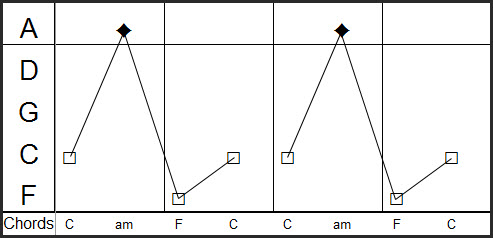 The chorus is in the relative major of C. C major is a classic big spacious key, strong enough to carry the emotions of this song. The am chord is also used and the home key of C is reached from the IV (F) in true rock style rather than the more classical V(G) approach. The Middle 8 oscillates shamelessly between “C” major and “a” minor, two keys that are so similar that you can play their scales using exactly the same notes. This means that they are perfect for jamming around with guitars and voices.
The chorus is in the relative major of C. C major is a classic big spacious key, strong enough to carry the emotions of this song. The am chord is also used and the home key of C is reached from the IV (F) in true rock style rather than the more classical V(G) approach. The Middle 8 oscillates shamelessly between “C” major and “a” minor, two keys that are so similar that you can play their scales using exactly the same notes. This means that they are perfect for jamming around with guitars and voices.  Coming off the C-am rocking harmony we land on the G Major chord again. This leads the ear to expect C Major next as it did into the chorus. However we are not given our promised C Major and we land on F Major instead which is a IV-I, a far more common rock cadence. A classic song that uses many classic and classical techniques to make it sound big and satisfying.
Coming off the C-am rocking harmony we land on the G Major chord again. This leads the ear to expect C Major next as it did into the chorus. However we are not given our promised C Major and we land on F Major instead which is a IV-I, a far more common rock cadence. A classic song that uses many classic and classical techniques to make it sound big and satisfying.
Bitter Sweet Symphony – The Verve
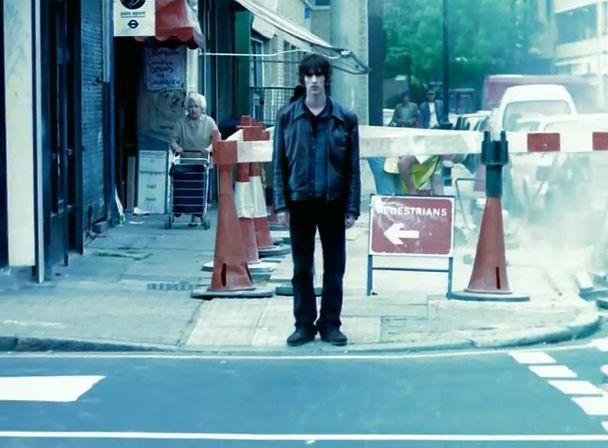 Well we have our first true 4-chord song. E-bm-D-A. Of course it is never quite as simple as that. There are subtleties in the voicing of these chords that give this song its distinctive rich sound. We have, of course the sweeping strings that provide the lush bedding for the song as well as the iconic riff that runs throughout. However the chord progression remains stubbornly the same throughout the Intro, Verse, Chorus and Outro. Perhaps reminding us of the futility of life and the mundane repetition of each day that is reflected in the words. Harmonically speaking, there are complexities in the harmony also. On first hearing, it is not clear that the second chord is b minor. It sounds like D major and this is a good example of how the ii and the IV chord can be used interchangeably as they fulfill the same function. We need only add a B to a D major chord to make a D6: D – F# – A – B and we have made ourselves b minor 7: B – D – F# – A. These two chords are the same, and it can be difficult and pointless to try and discriminate between them sometimes. In this case we can just about distinguish the bassline enough to name the chords as they are. There is also a string line that is playing the note “E” underneath the D chord so more precisely it is D/E, or D9 or maybe Dsus2 – they all describe the addition of the note E. Following the tried and tested formula of sweeping strings and straining vocals, poignant lyrics and heavy guitars, the chords themselves seem somewhat redundant, easily replaceable by any coherent progression to much the same effect. No matter, let’s look at the small amount of information we do have. This progression looks like this on a seechord chart:
Well we have our first true 4-chord song. E-bm-D-A. Of course it is never quite as simple as that. There are subtleties in the voicing of these chords that give this song its distinctive rich sound. We have, of course the sweeping strings that provide the lush bedding for the song as well as the iconic riff that runs throughout. However the chord progression remains stubbornly the same throughout the Intro, Verse, Chorus and Outro. Perhaps reminding us of the futility of life and the mundane repetition of each day that is reflected in the words. Harmonically speaking, there are complexities in the harmony also. On first hearing, it is not clear that the second chord is b minor. It sounds like D major and this is a good example of how the ii and the IV chord can be used interchangeably as they fulfill the same function. We need only add a B to a D major chord to make a D6: D – F# – A – B and we have made ourselves b minor 7: B – D – F# – A. These two chords are the same, and it can be difficult and pointless to try and discriminate between them sometimes. In this case we can just about distinguish the bassline enough to name the chords as they are. There is also a string line that is playing the note “E” underneath the D chord so more precisely it is D/E, or D9 or maybe Dsus2 – they all describe the addition of the note E. Following the tried and tested formula of sweeping strings and straining vocals, poignant lyrics and heavy guitars, the chords themselves seem somewhat redundant, easily replaceable by any coherent progression to much the same effect. No matter, let’s look at the small amount of information we do have. This progression looks like this on a seechord chart:  The most recognisable feature is the avoidance of the perfect cadence once more. This is a classic rock progression, instantly providing a “Bluesy” feel by using the bm7. The reason I say that is because bm7 consists of the notes: B-D-F#-A. The “D” of this chord falls outside the conventional E major scale which we would expect to be used as the piece is in the key of E. The D natural represents the flattened 7th which is the first note we would expect to be changed in a scale, and a very common alteration to provide a rock or blues feel. The bm7 then leads into the D major which in harmonic terms is the same chord really, at least it fulfills many of the same functions. The D then rises back through the IV chord (A) and then the sequence starts again. This progressions is almost identical to the chorus of Robbie Williams’ “Angels” – a tried and tested formula for a classic. The progression goes on through the chorus, never changing at all. No more to say except if you want to write a classic, you don’t need to try too hard with your chord progressions.
The most recognisable feature is the avoidance of the perfect cadence once more. This is a classic rock progression, instantly providing a “Bluesy” feel by using the bm7. The reason I say that is because bm7 consists of the notes: B-D-F#-A. The “D” of this chord falls outside the conventional E major scale which we would expect to be used as the piece is in the key of E. The D natural represents the flattened 7th which is the first note we would expect to be changed in a scale, and a very common alteration to provide a rock or blues feel. The bm7 then leads into the D major which in harmonic terms is the same chord really, at least it fulfills many of the same functions. The D then rises back through the IV chord (A) and then the sequence starts again. This progressions is almost identical to the chorus of Robbie Williams’ “Angels” – a tried and tested formula for a classic. The progression goes on through the chorus, never changing at all. No more to say except if you want to write a classic, you don’t need to try too hard with your chord progressions.
With or Without You – U2
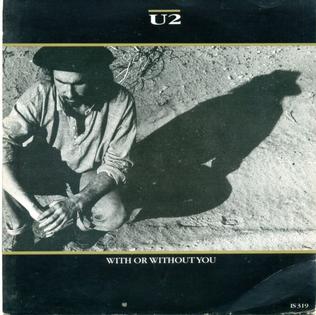 See the stone set in your eyes See the thorn twist in your side I’ll wait for you. D-A-bm-G. Having had our first song using only one chord progression with Bittersweet Symphony, we now have another but this time using THE classic 4-chord progression. Do check out the Axis of Awesome version to really get it. I-V-vi-IV. Currently there are 174 entries on the wiki page for this chord progression showing just how iconic this sound is. I would like to know why so let’s dig into it a little. The first thing that I notice is that when repeated, this progression gives us the IV-i cadence known as plagal, but I like to call it the Rock Cadence due to its prevalence in rock music. I-V-vi-[IV – I]-V-vi-IV This gives the harmony a clean, hard edge as opposed to the V-I cadence known as the perfect cadence that is found predominantly in classical music. See the cadences page for a fuller explanation of this. The next feature is the use of the relative minor chord, in this case the b minor. This allows the tune to stay on the same note, but the harmony to change underneath it which gives a lovely plaintive harmonisation. This happens here with the tune starting on an F# over the initial D chord, and then landing on F# again for the bm: F# G F# E D E F# – Tune Sleight of hand and twist of fate D A bm – Chords. The V chord – in this case A – also gets a look in with this progression which is an uplifting move to the “dominant”. There are many rock songs that barely use the V chord and they tend to have a darker feel to them. Most of the 4-chord songs are feel-good tunes and I think this is one of the reasons why. Here is the 4-chord song on a SeeChord chart:
See the stone set in your eyes See the thorn twist in your side I’ll wait for you. D-A-bm-G. Having had our first song using only one chord progression with Bittersweet Symphony, we now have another but this time using THE classic 4-chord progression. Do check out the Axis of Awesome version to really get it. I-V-vi-IV. Currently there are 174 entries on the wiki page for this chord progression showing just how iconic this sound is. I would like to know why so let’s dig into it a little. The first thing that I notice is that when repeated, this progression gives us the IV-i cadence known as plagal, but I like to call it the Rock Cadence due to its prevalence in rock music. I-V-vi-[IV – I]-V-vi-IV This gives the harmony a clean, hard edge as opposed to the V-I cadence known as the perfect cadence that is found predominantly in classical music. See the cadences page for a fuller explanation of this. The next feature is the use of the relative minor chord, in this case the b minor. This allows the tune to stay on the same note, but the harmony to change underneath it which gives a lovely plaintive harmonisation. This happens here with the tune starting on an F# over the initial D chord, and then landing on F# again for the bm: F# G F# E D E F# – Tune Sleight of hand and twist of fate D A bm – Chords. The V chord – in this case A – also gets a look in with this progression which is an uplifting move to the “dominant”. There are many rock songs that barely use the V chord and they tend to have a darker feel to them. Most of the 4-chord songs are feel-good tunes and I think this is one of the reasons why. Here is the 4-chord song on a SeeChord chart:  So that is the 4-chord song. Add some evocative language and some plaintive guitar and you have yourself an instant hit.
So that is the 4-chord song. Add some evocative language and some plaintive guitar and you have yourself an instant hit.
Penny Lane/Strawberry Fields – The Beatles
These are two very different songs but were released as a double A side. I don’t see many similarities so I’ll treat them individually.
Penny Lane – Paul McCartney
Once again I have to lament the online resources I found that list the original key as A or G. This song is in the key of B. There, finished. A classic McCartney song with a classic chord sequence for the verse. He jumps from the B chord to its relative minor (G#) and then falls through the fifths back to B again: B-g#m-c#m-F#7-B. On the Seechord chart it looks very familiar: 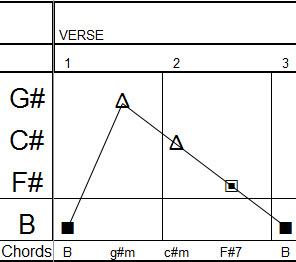 This is Classical writing at its essence, following in the footsteps of Bach. What we cannot see in the chords though is the delightful descending bassline that gives this song its characteristic jaunty feel. I suppose we should not be too surprised that McCartney’s songs have classic basslines really. Here’s how the bass moves under the chords: Chords:B g#m c#m F#7 Bass: B-A#-G#-F#-E-C#-F#-F# The Bass part also plays a huge part in the next few chords which see the unusual shift from B major to b minor: B-bm-g#half dim-Gmaj7-F#. What a mess to read. The chart hardly helps either:
This is Classical writing at its essence, following in the footsteps of Bach. What we cannot see in the chords though is the delightful descending bassline that gives this song its characteristic jaunty feel. I suppose we should not be too surprised that McCartney’s songs have classic basslines really. Here’s how the bass moves under the chords: Chords:B g#m c#m F#7 Bass: B-A#-G#-F#-E-C#-F#-F# The Bass part also plays a huge part in the next few chords which see the unusual shift from B major to b minor: B-bm-g#half dim-Gmaj7-F#. What a mess to read. The chart hardly helps either:  Looks terrible – like some avant garde piece. But this is Paul McCartney so surely this is a moment of madness for him? Not when we take the bassline into account. We can just as easily view the harmony here as staying on b minor the whole way through these chords, with the bass dropping underneath it like this: Chords:B-bm-bm-bm-F# Bass: B-B – G# -G – F# This simplifies the entire verse down to this:
Looks terrible – like some avant garde piece. But this is Paul McCartney so surely this is a moment of madness for him? Not when we take the bassline into account. We can just as easily view the harmony here as staying on b minor the whole way through these chords, with the bass dropping underneath it like this: Chords:B-bm-bm-bm-F# Bass: B-B – G# -G – F# This simplifies the entire verse down to this:  Now this looks more like a normal McCartney song to me. There are a couple of awkward moments of song writing here that somehow serve only to make it more endearing – perhaps because I am so familiar with the song. The first is the rather weird choice to have the chorus in A. Maybe the choice of lyrics “Very strange” over the E chord that prepares the chorus is no accident? This leads us to the other strange moment which is the return to the B major for the original verse. McCartney can hardly bear to have a key change that is not properly prepared with a Perfect Cadence so he jumps from the D at the end of the chorus to the F#7 to get back to B: “Beneath the blue suburban skies I sit and meanwhile back in Penny Lane” A A/C# D F#7 B And that is Penny Lane.
Now this looks more like a normal McCartney song to me. There are a couple of awkward moments of song writing here that somehow serve only to make it more endearing – perhaps because I am so familiar with the song. The first is the rather weird choice to have the chorus in A. Maybe the choice of lyrics “Very strange” over the E chord that prepares the chorus is no accident? This leads us to the other strange moment which is the return to the B major for the original verse. McCartney can hardly bear to have a key change that is not properly prepared with a Perfect Cadence so he jumps from the D at the end of the chorus to the F#7 to get back to B: “Beneath the blue suburban skies I sit and meanwhile back in Penny Lane” A A/C# D F#7 B And that is Penny Lane.
Strawberry Fields
This unique classic of early psychedelic rock is infused with dreamy lyrics, wild orchestration, shifting harmonies, melodies and root notes. It is a swarm of sound, ideas and music, put together over 45 hours of recording in two different keys (A and B) and then mixed and spliced with tape and scissors into Bb Major. Harmonically we can instantly point to a number of very John Lennon-type attributes. Firstly let’s take the main cadences on the lyrics “Strawberry Fields Forever” at the end of the chorus, and also at the end of each verse. The chords come out as: Eb-Bb. In the key of Bb this is a IV-I (sometimes referred to as a plagal cadence). This is John’s signature on most of his songs and also for most rock songs. (See the page “Secrets of the Beatles” for more). Elsewhere in this song we have a fairly limited selection of chords: Bb, F, C, G, Eb. Both the F and G chords are heard in major and minor which is unusual. The most distinctive feature though is the sporadic movement between chords. Here is the Seechord chart:  I have looked at many of these charts over 10 years and there seems to be very little discernible pattern to this song that I can explain. That is what makes it so enigmatic and extraordinary. As I said, the chords themselves are not particularly exotic, nor the melody, but they are put together in such a shambolic way and that is what leads us into the world of John Lennon. Hazy, half-formed dream-like music that transcends the rules. Genius.
I have looked at many of these charts over 10 years and there seems to be very little discernible pattern to this song that I can explain. That is what makes it so enigmatic and extraordinary. As I said, the chords themselves are not particularly exotic, nor the melody, but they are put together in such a shambolic way and that is what leads us into the world of John Lennon. Hazy, half-formed dream-like music that transcends the rules. Genius.
Good Vibrations – The Beach Boys
 It was with some trepidation that I approached this song, having had to make arrangements of it in the past and play it on my keyboard, I know the twists and turns, unpredictable key changes and lush arrangement that make this song a classic. However the harmony bears up to close inspection and turns out to be quite a conventional song after all. There is also a wonderful serendipity to the shape of the chords on a SeeChord chart. Read on to find out more! So the opening Verse to the words, “I love the colourful clothes you wear”. The chords are ebm – bbm – abm – Bb. Is the song in eb minor though? If not then what key is it in? Do we care? Does it make any difference? Perhaps not, but it is interesting enough in itself that the home key or tonic is ambiguous. The starting chord is eb minor, the finishing chord Ab major. The Haunting bridge is solidly in F and the chorus moves clunkily between Gb Ab and Bb major so your guess is as good as mine really. Geek alert for this next bit: Here is the SeeChord chart for the verse. The geeky bit is the fact that I have joined up the chords in two different ways to show the bassline movement more clearly…
It was with some trepidation that I approached this song, having had to make arrangements of it in the past and play it on my keyboard, I know the twists and turns, unpredictable key changes and lush arrangement that make this song a classic. However the harmony bears up to close inspection and turns out to be quite a conventional song after all. There is also a wonderful serendipity to the shape of the chords on a SeeChord chart. Read on to find out more! So the opening Verse to the words, “I love the colourful clothes you wear”. The chords are ebm – bbm – abm – Bb. Is the song in eb minor though? If not then what key is it in? Do we care? Does it make any difference? Perhaps not, but it is interesting enough in itself that the home key or tonic is ambiguous. The starting chord is eb minor, the finishing chord Ab major. The Haunting bridge is solidly in F and the chorus moves clunkily between Gb Ab and Bb major so your guess is as good as mine really. Geek alert for this next bit: Here is the SeeChord chart for the verse. The geeky bit is the fact that I have joined up the chords in two different ways to show the bassline movement more clearly… 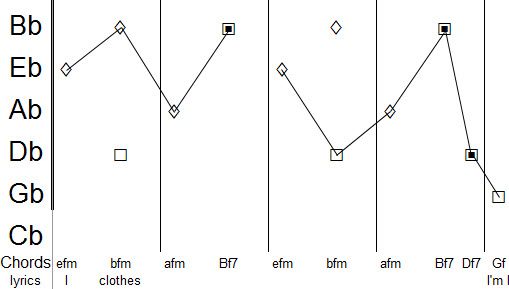 The first four chords I have joined up according to the real harmonies that are played: ebm – bbm – abm – Bb The next four I have put in the Db as the second chord which is the note the bass part plays. The bassline really defines this progression and uses a standard descending pattern. I always assumed that the second chord was Db major until I listened more carefully. The most popular guitar chord site lists the opening chords as “D-C-A#-A7” which is a travesty in so many ways. Wrong key, wrong second chord, wrong use of A#. The second listing also gets it wrong. There is a decent analysis here though (though he still lists the second chord as Db major) – hey maybe it’s me that’s wrong. Whichever is right, it is clearly hard to distinguish and that is why I have shown both progressions on the chart. The Db chord right at the end of the verse takes us neatly by way of a perfect cadence to the relative major of Gb. Here it stays for a couple of bars before rising by a tone twice without any preparation or diatonic movement (both Ab and Bb chords should be minor in the key of Gb Major). Here’s the chart showing those rises in key:
The first four chords I have joined up according to the real harmonies that are played: ebm – bbm – abm – Bb The next four I have put in the Db as the second chord which is the note the bass part plays. The bassline really defines this progression and uses a standard descending pattern. I always assumed that the second chord was Db major until I listened more carefully. The most popular guitar chord site lists the opening chords as “D-C-A#-A7” which is a travesty in so many ways. Wrong key, wrong second chord, wrong use of A#. The second listing also gets it wrong. There is a decent analysis here though (though he still lists the second chord as Db major) – hey maybe it’s me that’s wrong. Whichever is right, it is clearly hard to distinguish and that is why I have shown both progressions on the chart. The Db chord right at the end of the verse takes us neatly by way of a perfect cadence to the relative major of Gb. Here it stays for a couple of bars before rising by a tone twice without any preparation or diatonic movement (both Ab and Bb chords should be minor in the key of Gb Major). Here’s the chart showing those rises in key:  Then we stay on Bb for a while, then Eb, and then what I am calling the middle 8 which is clearly the most conventional part of the song.
Then we stay on Bb for a while, then Eb, and then what I am calling the middle 8 which is clearly the most conventional part of the song.  Now this looks satisfyingly like a wave, be it a sound wave or a sea wave. Serendipitous Seechord moment or does this actually reflect the fact that the harmony is wave like? Perhaps a bit of both. F-gm-C7-F is a nice neat traditional I-ii-V7-I progresson, not out of place in a Mozart opera. The final chorus section repeats the key shift motif from before:
Now this looks satisfyingly like a wave, be it a sound wave or a sea wave. Serendipitous Seechord moment or does this actually reflect the fact that the harmony is wave like? Perhaps a bit of both. F-gm-C7-F is a nice neat traditional I-ii-V7-I progresson, not out of place in a Mozart opera. The final chorus section repeats the key shift motif from before: 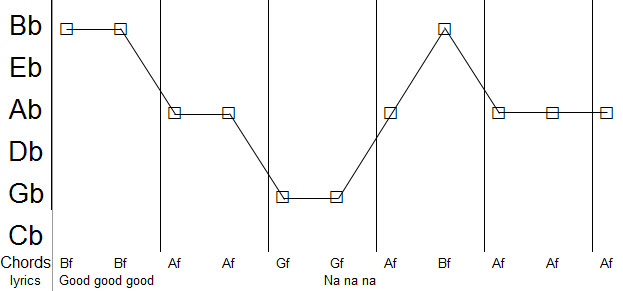 This time we go down first and then back up again. Hmmmm I’m thinking of waves again….Gotta keep those good love….vibrations happening…aaaah
This time we go down first and then back up again. Hmmmm I’m thinking of waves again….Gotta keep those good love….vibrations happening…aaaah
Losing my Religion – R.E.M.
 The quirky mandolin based introduction sets up the feel for this whole song. Straightforward. This is a classic way to write a song using very simple building blocks. Indeed the song was written as a result of Peter Buck learning to play the mandolin while sitting in front of the television. The chords for the verse are: am-em-am-em-am-em-dm-G. It looks like this on a SeeChord chart.
The quirky mandolin based introduction sets up the feel for this whole song. Straightforward. This is a classic way to write a song using very simple building blocks. Indeed the song was written as a result of Peter Buck learning to play the mandolin while sitting in front of the television. The chords for the verse are: am-em-am-em-am-em-dm-G. It looks like this on a SeeChord chart.  Worth noting the heavy reliance on minor chords here. The next section (not really chorus-worthy) to the words, “I thought that I heard…” is equally simple harmonically: F – (G) – am F – am – G F is not the official relative major of ‘a’ minor, but it is very closely related so it comes as no shock to the ear to hear it. There is also a kind of bridge section, “That was just a dream” to the chords: C-dm-C-dm. So not a great deal for a geeky music harmony detective like me to get my teeth into really. Just goes to show again that to write a great song, you don’t need to try to hard to create good chords.
Worth noting the heavy reliance on minor chords here. The next section (not really chorus-worthy) to the words, “I thought that I heard…” is equally simple harmonically: F – (G) – am F – am – G F is not the official relative major of ‘a’ minor, but it is very closely related so it comes as no shock to the ear to hear it. There is also a kind of bridge section, “That was just a dream” to the chords: C-dm-C-dm. So not a great deal for a geeky music harmony detective like me to get my teeth into really. Just goes to show again that to write a great song, you don’t need to try to hard to create good chords.
Like a Rolling Stone – Bob Dylan
 I will admit that I have never really paid much attention to this song so it was an education for me to listen to it with an analytical ear. At first it seems to fall into the ‘simple’ category of songs in terms of its harmony but there are some lovely uses of movement that reflect the words and some real surprises. Firstly, the chords of the Verse:
I will admit that I have never really paid much attention to this song so it was an education for me to listen to it with an analytical ear. At first it seems to fall into the ‘simple’ category of songs in terms of its harmony but there are some lovely uses of movement that reflect the words and some real surprises. Firstly, the chords of the Verse:
C-dm-em-F-G C-dm-em-F-G
F-G-F-G F-em-dm-C F-em-dm-C dm-F-G The most obvious observation is the rising harmony C-d-e-F-G that then falls F-e-d-C later. On a Seechord chart it looks a little different:  However, if we tweak the order of chords on the y-axis so that there are arranged ‘diatonically‘ rather than in 5ths we can see the pattern more clearly:
However, if we tweak the order of chords on the y-axis so that there are arranged ‘diatonically‘ rather than in 5ths we can see the pattern more clearly: Now we can see the beautiful rolling harmony laid out before us. It is worth saying that this is an extremely rare chord sequence. In Classical terms it would be sacrilege to use such parallel harmonic movement. You could play these chords by holding your hand in the root chord position on C on the piano and just moving up one note each time. Moving from dm(iim) to em(iiim) is basically unheard of. However it gives a rather naive and bold feeling to the song. The chorus is as simple as it could be really: C-F-G (I-IV-V) repeated many times with an AAAA rhyme scheme – ‘own’ ‘home’ ‘unknown’ ‘stone’. All of this adds to the feeling of a rolling, repetitive homeless life, at least it does to me. Of course as ever the harmony is not the full story, the wonderful organ sound, Dylan’s searching voice, lyrics stuffed with imagery, the jangling guitar sound and the ubiquitous harmonica all pitch in to make this a classic.
Now we can see the beautiful rolling harmony laid out before us. It is worth saying that this is an extremely rare chord sequence. In Classical terms it would be sacrilege to use such parallel harmonic movement. You could play these chords by holding your hand in the root chord position on C on the piano and just moving up one note each time. Moving from dm(iim) to em(iiim) is basically unheard of. However it gives a rather naive and bold feeling to the song. The chorus is as simple as it could be really: C-F-G (I-IV-V) repeated many times with an AAAA rhyme scheme – ‘own’ ‘home’ ‘unknown’ ‘stone’. All of this adds to the feeling of a rolling, repetitive homeless life, at least it does to me. Of course as ever the harmony is not the full story, the wonderful organ sound, Dylan’s searching voice, lyrics stuffed with imagery, the jangling guitar sound and the ubiquitous harmonica all pitch in to make this a classic.
God Only Knows by The Beach Boys
 Wow. I genuinely had no idea that this song would hold so many intricate and complex harmonies, transient and indefinable chords, divine and unique voicings. This to me is a good example of a song that sounds conventional simply from many listenings. It is far from conventional, in fact it is the most imaginative and extraordinary use of harmony I have ever analysed in a song. Bohemian rhapsody comes close with its wonderful array of styles and key changes but in “God only knows” virtually every chord has some unusual feature about it. One of the most striking of these features is the avoidance of root position chords. This will lead to a very mobile harmony, one that never settles and always leans towards the next chord. It also produces a very melodious bass line. The harmony only settles on root position chords (or chords with the root note in the bass) at the words “God only knows” which is a lovely example of the harmony reflecting the lyrics or vice versa. I have to admit that this is one of those occasions where a SeeChord chart does not really throw much light on the situation. I would love to say that suddenly the harmony becomes clear and starts obeying the rules but it just doesn’t. There is one section I like though as it demonstrates the use of diminished chords very nicely. It is a little four chord pattern that first appears on the words, “You never need to doubt it, I’ll make you so sure about it”
Wow. I genuinely had no idea that this song would hold so many intricate and complex harmonies, transient and indefinable chords, divine and unique voicings. This to me is a good example of a song that sounds conventional simply from many listenings. It is far from conventional, in fact it is the most imaginative and extraordinary use of harmony I have ever analysed in a song. Bohemian rhapsody comes close with its wonderful array of styles and key changes but in “God only knows” virtually every chord has some unusual feature about it. One of the most striking of these features is the avoidance of root position chords. This will lead to a very mobile harmony, one that never settles and always leans towards the next chord. It also produces a very melodious bass line. The harmony only settles on root position chords (or chords with the root note in the bass) at the words “God only knows” which is a lovely example of the harmony reflecting the lyrics or vice versa. I have to admit that this is one of those occasions where a SeeChord chart does not really throw much light on the situation. I would love to say that suddenly the harmony becomes clear and starts obeying the rules but it just doesn’t. There is one section I like though as it demonstrates the use of diminished chords very nicely. It is a little four chord pattern that first appears on the words, “You never need to doubt it, I’ll make you so sure about it”  Serious geek warning here – this is horrendously complex to explain. Here is that small section on the chart. Diminished chords are ambiguous by nature and there is usually no sense in trying to establish a “root note” as they are all interchangeable. This means that diminished chord can be played in any inversion or with any of the notes in the bass with little effect to the sound of the chord. Another ambiguity is the fact that diminished and half-diminished chords are often 7th or 9th chords in disguise as I believe these chords here are. If we were to write the sequence it would most likely be written as – E/B – cdim – E/B – a#min7-5 (or a half diminished). This is complicated but it does obscure a simpler harmony that I have shown in the chart. C diminished contains the notes C-Eb-F#-A. I have shown those notes on the chart, but I have also shown B7. This is because B7 contains three of those notes (Eb-F# and A). In fact B flat 9 contains all four of those notes and so this diminished chor d could also be seen as B b9 with no root. Incidentally it could also be seen as D, F or Ab flat 9 chords with no root! The ear is far more sensitive to these alternative chords than the brain and so it will fill in those missing notes and give a more logical sense to the harmony. A similar effect is seen with half-diminished chords but these give 9chords instead of flat 9 chords. The SeeChord chart can seriously help to navigate these ambiguous moments by giving us a chance to see the pattern and find our way through by finding the simplest visual patter. I usually find that this is then backed up by listening. That is all I can muster on this song for now – it has nearly broken me and the SeeChord system but we have emerged older and wiser and certainly with a renewed appreciation for the wildly nonconformist music of The Beach Boys. Phew.
Serious geek warning here – this is horrendously complex to explain. Here is that small section on the chart. Diminished chords are ambiguous by nature and there is usually no sense in trying to establish a “root note” as they are all interchangeable. This means that diminished chord can be played in any inversion or with any of the notes in the bass with little effect to the sound of the chord. Another ambiguity is the fact that diminished and half-diminished chords are often 7th or 9th chords in disguise as I believe these chords here are. If we were to write the sequence it would most likely be written as – E/B – cdim – E/B – a#min7-5 (or a half diminished). This is complicated but it does obscure a simpler harmony that I have shown in the chart. C diminished contains the notes C-Eb-F#-A. I have shown those notes on the chart, but I have also shown B7. This is because B7 contains three of those notes (Eb-F# and A). In fact B flat 9 contains all four of those notes and so this diminished chor d could also be seen as B b9 with no root. Incidentally it could also be seen as D, F or Ab flat 9 chords with no root! The ear is far more sensitive to these alternative chords than the brain and so it will fill in those missing notes and give a more logical sense to the harmony. A similar effect is seen with half-diminished chords but these give 9chords instead of flat 9 chords. The SeeChord chart can seriously help to navigate these ambiguous moments by giving us a chance to see the pattern and find our way through by finding the simplest visual patter. I usually find that this is then backed up by listening. That is all I can muster on this song for now – it has nearly broken me and the SeeChord system but we have emerged older and wiser and certainly with a renewed appreciation for the wildly nonconformist music of The Beach Boys. Phew.
Everybody Hurts by R.E.M.
 If there was ever a song that fell into the “Simple Classic” category then this is it. Indeed the song was written for a teenage audience with the lyrics that reach out to all those self-searching misunderstood angsty teeangers who thinks that nobody understands their pain. Well be comforted because REM understand, and they made a lot of money out of understanding. So far as the harmony goes it is the most elegantly simple example of a “rocking” harmony I have come across. A rocking harmony D-G-D-G is one that goes from one chord to another and then back again, usually from a I to a V chord such as C-G-C-G. The chords for this song are three sets of rocking harmonies, one for the verse, one for the chorus and one for the middle 8, with a “turnaround” at the end to get us back to the verse again. em-A-em-A F#-bm-F#-bm Here is what it looks like on a SeeChord chart:
If there was ever a song that fell into the “Simple Classic” category then this is it. Indeed the song was written for a teenage audience with the lyrics that reach out to all those self-searching misunderstood angsty teeangers who thinks that nobody understands their pain. Well be comforted because REM understand, and they made a lot of money out of understanding. So far as the harmony goes it is the most elegantly simple example of a “rocking” harmony I have come across. A rocking harmony D-G-D-G is one that goes from one chord to another and then back again, usually from a I to a V chord such as C-G-C-G. The chords for this song are three sets of rocking harmonies, one for the verse, one for the chorus and one for the middle 8, with a “turnaround” at the end to get us back to the verse again. em-A-em-A F#-bm-F#-bm Here is what it looks like on a SeeChord chart:  There is little more to say really. The chart shows an elegant rising of a tone each time the harmony changes from D to em to F#. It is that rise to F# that really pulls on the heart strings and that is when the full arrangement really kicks in. Goes to show how simple a simple song should be.
There is little more to say really. The chart shows an elegant rising of a tone each time the harmony changes from D to em to F#. It is that rise to F# that really pulls on the heart strings and that is when the full arrangement really kicks in. Goes to show how simple a simple song should be.
Waterloo Sunset by The Kinks

One of The Kinks’ most successful and commercial recordings, Waterloo Sunset is a simple narrative about two lovers crossing Waterloo Bridge. The chords are deceptively simple using only 6 chords for the whole song with some major/minor changes. There is a 4-bar intro on the dominant of B7 into a perfectly simple I-V-IV:
E-B-A
The bridge section (pun intended) goes:
F#-B-F#-B7 which leads us back to E for the next verse.
That’s it. However, the genius of this song in terms of the harmony is in the bassline. Even in the introduction we get that wonderful descending passage: B-A-G#-F#-E-D#-C#-B – a full octave descending scale in the base. In the three chord hook of the verse we only have one root position bass note on the first chord and the ‘A’ chord is harmonised with the 3rd in in the bass which gives us a wonderful sense of not being home yet.. Take the chords under the words, “And I wont feel afraid”. The chords are:
f#m-C#-A-B. Here they are along with the final three chords of the verse on a SeeChord chart:
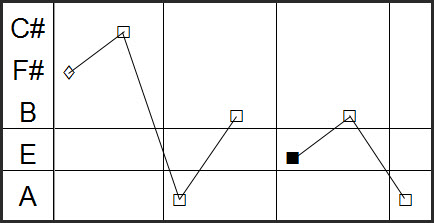
Nothing unusual there, but the bassline tells us a different story falling chromatically from F#-F-E-D#. Then in the final three chords we get that unresolved C# under the ‘A’ chord again.
A simple song with simple lyrics, a wonderful arrangement and production from Ray Davies, this is one of the most elegant, evocative and beautiful songs of all time.
Don’t Look Back in Anger – Oasis
Another iconic song of course by the juggernaut that was Oasis. Lyrics and arrangement inspired by John Lennon in places and featuring Noel on voice for the first time. The song does not seem to mean very much by Noel’s own admission but a great chord progression and the Britpop/rock sound seems to be enough in this case to create a classic. Let’s look at the harmony:
After the ‘Imagine’ opening of C-F-C-F we get to the verse, which has the same chords as the chorus:
C-G-am-E7-F-G-C. On a Seechord chart it looks like this:
 It looks quite unusual and if it were not for the F instead of am it would be symmetrical which is almost unheard of for a chord progression. Anyway the key point is the E7 chord. In the key of C major as this song is, we would not really expect an E7 so soon in the progression, but the fact that we have had aminor just before it means that the E7 is acting as the dominant to aminor. However it does not resolve back into aminor, choosing instead to resolve to F major (the relative major of aminor). It is this scrunchy and unorthadox little move that gives the whole song it’s feel in my opinion. The same thing happens in the ‘prechorus’ under the lyrics “Take that look from off your face” except this time we do resolve to the aminor:
It looks quite unusual and if it were not for the F instead of am it would be symmetrical which is almost unheard of for a chord progression. Anyway the key point is the E7 chord. In the key of C major as this song is, we would not really expect an E7 so soon in the progression, but the fact that we have had aminor just before it means that the E7 is acting as the dominant to aminor. However it does not resolve back into aminor, choosing instead to resolve to F major (the relative major of aminor). It is this scrunchy and unorthadox little move that gives the whole song it’s feel in my opinion. The same thing happens in the ‘prechorus’ under the lyrics “Take that look from off your face” except this time we do resolve to the aminor:
G-E7-am-G-F
By all accounts this song was devised by just sitting and strumming as most of the best songs are. Noel Gallagher just happened to sit and strum his way to a Platinum single on this occasion.
Whiter Shade of Pale – Procul Harum

This seems like a pretty simple and charming chords sequence, based largely on the voicing and arrangements of J.S.Bach, and in particular his “Air on a G String”. The descending bassline is instantly recognisable along with the hammond organ sound, and with the prog rock lyrics it shot this single to the top of most of the worldwide charts and sold over 10 million copies. So how did they do it? Is it a complete rip off of Bach?
The chords themselves are largely produced by holding a chord and dropping the bass underneath it. If you play a C chord on the piano with a C in the Bass it is C Major. Drop the bass a step to B and you get C Maj7, Down to A is am7 and down again to G gives Cmajor/G. The chords look like this:
C-Cmaj7-am7-C/G.
This is then repeated with an F chord and a G chord. The Seechord chart shows it quite well, but obviously without the visual of the descending bassline:
The chord sequence produces these lovely little witches hat shapes as the harmony switches from the major to the relative minor (C-am, F-dm, G-em). At first I thought there were few secrets or interesting observations beyond this but then when I was writing out the chords I noticed that the meter of the lyrics and the phrases of the chord sequence don’t match in a most peculiar way.
Usually we expect musical phrases to be 2 or 4 or 8 bars long. Exceptions are rare and when they do occur it is often an extended or curtailed phrase surrounded by more conventional ones. The lyrics fall neatly into four-line stanzas which is reinforced by the rhyme scheme – A-B-C-B. 2 of these make up the verse and one more is the chorus. However, the musical phrase follows a 3-3-2-4 phrase pattern which totally cuts across the lyrics! You can see the mismatch pretty clearly on the SeeChord chart:
The Intro and the Chorus both fit nice conventional 4 bar phrases, but the verse is oddly chopped up so that the musical sequence restarts at bar 8, but the lyrical phrase restarts at bar 9. I don’t recall ever seeing this in any song before, nor do I think I ever really noticed this while listening to the track. Perhaps it lends to that feeling of surreal drug-induced haze that this song seems to inspire. Perhaps it was an accident or intended that way, but either way I find it fascinating. Here is the chorus by the way:
So there you have it. “Whiter Shade of Pale” holds hidden mysteries that are above the minds of mere mortal geeks like myself.
Stairway to Heaven
It is not the first time I have tackled an analysis of this great classic. In fact I did a pretty thorough job last time so here it is!



